Effect of Rosin Modification on the Visual Characteristics of Round Bamboo Culm
Abstract
:1. Introduction
2. Materials and Methods
2.1. Impregnation of the Bamboo Culm with Rosin
2.2. Measurement of Color and Gloss
2.3. Micromorphology Characteristics
2.4. Micromorphology Characteristics
2.5. Eye Tracking Test
3. Results and Discussion
3.1. Color and Gloss
3.2. Surface Topography Characteristics
3.3. FTIR Spectroscopy
3.4. Eye Tracking Analysis
4. Conclusions
Author Contributions
Funding
Data Availability Statement
Acknowledgments
Conflicts of Interest
References
- Van der Lugt, P.; Van den Dobbelsteen, A.A.J.F.; Janssen, J.J.A. An environmental, economic and practical assessment of bamboo as a building material for supporting structures. Constr. Build. Mater. 2006, 20, 648–656. [Google Scholar] [CrossRef]
- Liese, W.; Köhl, M. Bamboo; Springer: Cham, Switzerland, 2015. [Google Scholar]
- Manandhar, R.; Kim, J.H.; Kim, J.T. Environmental, social and economic sustainability of bamboo and bamboo-based construction materials in buildings. J. Asian Archit. Build. Eng. 2019, 18, 49–59. [Google Scholar] [CrossRef]
- Miclat, M.C. The visual poetry of Chinese bamboo: Some notes on traditional Chinese Xieyi painting. Humanit. Diliman 2000, 1, 22–35. [Google Scholar]
- Wang, X.Y. Study on aesthetic application of the original bamboo in assembled bamboo buildings. Adv. Educ. Res. 2012, 4, 375–379. [Google Scholar]
- Weibel, D.; Stricker, D.; Wissmath, B.; Mast, F.W. How Socially Relevant Visual Characteristics of Avatars Influence Impression Formation. J. Media Psychol. 2010, 22, 37–43. [Google Scholar] [CrossRef]
- Küller, R.; Ballal, S.; Laike, T.; Mikellides, B.; Tonello, G. The impact of light and colour on psychological mood: A cross-cultural study of indoor work environments. Ergonomics 2006, 49, 1496–1507. [Google Scholar] [CrossRef]
- Levy, B.I. Research into the psychological meaning of color. Am. J. Art Ther. 1984, 23, 58–62. [Google Scholar]
- Jiang, Z. Bamboo and Rattan in the World; China Forestry Pub. House: Beijing, China, 2007. [Google Scholar]
- Jacobs, K.W.; Blandino, S.E. Effects of color of paper on which the profile of mood states is printed on the psychological states it measures. Percept. Mot. Ski. 1992, 75, 267–271. [Google Scholar] [CrossRef]
- Adams, W.J.; Kerrigan, I.S.; Graf, E.W. Touch influences perceived gloss. Sci. Rep. 2016, 6, 386855. [Google Scholar] [CrossRef] [Green Version]
- Wastiels, L.; Schifferstein, H.N.; Heylighen, A.; Wouters, I. Relating material experience to technical parameters: A case study on visual and tactile warmth perception of indoor wall materials. Build. Environ. 2012, 49, 359–367. [Google Scholar] [CrossRef]
- Rosu, D.; Teaca, C.-A.; Bodirlau, R.; Rosu, L. FTIR and color change of the modified wood as a result of artificial light irradiation. J. Photochem. Photobiol. B Biol. 2010, 99, 144–149. [Google Scholar] [CrossRef]
- Temiz, A.; Yildiz, U.C.; Aydin, I.; Eikenes, M.; Alfredsen, G.; Çolakoglu, G. Surface roughness and color characteristics of wood treated with preservatives after accelerated weathering test. Appl. Surf. Sci. 2005, 250, 35–42. [Google Scholar] [CrossRef]
- Kamdem, D.P.; Grelier, S. Surface Roughness and Color Change of Copper-Amine Treated Red Maple (Acer rubrum) Exposed to Artificial Ultraviolet Light. Holzforschung 2002, 56, 473–478. [Google Scholar] [CrossRef]
- Chang, S.-T.; Wu, J.-H. Stabilizing Effect of Chromated Salt Treatment on the Green Color of Ma Bamboo (Dendrocalamus latiflorus). Holzforschung 2000, 54, 327–330. [Google Scholar] [CrossRef]
- Zhou, T.; Shi, X.U.; Wang, Z.; Sun, D. Effect of heat treatment on texture and color changes in minimally processed water bamboo. J. Wuxi Univ. Light Ind. 2002, 16, 53–70. [Google Scholar]
- Feng, Q.; Huang, Y.; Ye, C.; Fei, B.; Yang, S. Impact of hygrothermal treatment on the physical properties and chemical composition of Moso bamboo (Phyllostachys edulis). Holzforschung 2021, 75, 614–625. [Google Scholar] [CrossRef]
- Karlberg, A.-T.; Magnusson, K. Rosin components identified in diapers. Contact Dermat. 1996, 34, 176–180. [Google Scholar] [CrossRef] [PubMed]
- Shaw, D.N.; Sebrell, L.B. The Chemical Composition of Rosin. Ind. Eng. Chem. 1926, 18, 612–614. [Google Scholar] [CrossRef]
- Su, Z.A.; Liang, Z.Q.; Qin, W.L.; Jiang, Z.R. Study on the principal chemical constituents of Chinese rosin and turpentine. Sci. Silvae Sin. 1980, 16, 214–220. [Google Scholar]
- Wang, J.-F.; Lin, M.-T.; Wang, C.-P.; Chu, F.-X. Study on the synthesis, characterization, and kinetic of bulk polymerization of disproportionated rosin (β-acryloxyl ethyl) ester. J. Appl. Polym. Sci. 2009, 113, 3757–3765. [Google Scholar] [CrossRef]
- Pathak, Y.V.; Dorle, A.K. Rosin and rosin derivatives as hydrophobic matrix materials for controlled release of drugs. Drug Des. Deliv. 1990, 6, 223–227. [Google Scholar]
- Mayer, M.; Meuldijk, J.; Thoenes, D. Emulsion polymerization of styrene with disproportionated rosin acid soap as emulsifier. J. Appl. Polym. Sci. 2010, 59, 1047. [Google Scholar] [CrossRef]
- Su, N.; Fang, C.; Yu, Z.; Zhou, H.; Wang, X.; Tang, T.; Zhang, S.; Fei, B. Effects of rosin treatment on hygroscopicity, dimensional stability, and pore structure of round bamboo culm. Constr. Build. Mater. 2021, 287, 123037. [Google Scholar] [CrossRef]
- Satturwar, P.M.; Fulzele, S.V.; Dorle, A.K. Biodegradation and in vivo biocompatibility of rosin: A natural film-forming polymer. AAPS PharmSciTech 2003, 4, 434–439. [Google Scholar] [CrossRef] [PubMed]
- Niu, X.; Liu, Y.; Song, Y.; Han, J.; Pan, H. Rosin modified cellulose nanofiber as a reinforcing and co-antimicrobial agents in polylactic acid/chitosan composite film for food packaging. Carbohydr. Polym. 2018, 183, 102–109. [Google Scholar] [CrossRef] [PubMed]
- Moustafa, H.; El Kissi, N.; Abou-Kandil, A.I.; Abdel-Aziz, M.S.; Dufresne, A. PLA/PBAT Bionanocomposites with Antimicrobial Natural Rosin for Green Packaging. ACS Appl. Mater. Interfaces 2017, 9, 20132–20141. [Google Scholar] [CrossRef] [PubMed]
- Dong, Y.; Yan, Y.; Wang, K.; Li, J.; Zhang, S.; Xia, C.; Shi, S.Q.; Cai, L. Improvement of water resistance, dimensional stability, and mechanical properties of poplar wood by rosin impregnation. Eur. J. Wood Wood Prod. 2016, 74, 177–184. [Google Scholar] [CrossRef]
- Nguyen, T.T.H.; Li, S.; Li, J. The combined effects of copper sulfate and rosin sizing agent treatment on some physical and mechanical properties of poplar wood. Constr. Build. Mater. 2013, 40, 33–39. [Google Scholar] [CrossRef]
- Dahlen, J.; Nicholas, D.D.; Schultz, T.P. Water Repellency and Dimensional Stability of Southern Pine Decking Treated with Waterborne Resin Acids. J. Wood Chem. Technol. 2008, 28, 47–54. [Google Scholar] [CrossRef]
- Su, N.; Fang, C.; Zhou, H.; Tang, T.; Zhang, S.; Fei, B. Hydrophobic treatment of bamboo with rosin. Constr. Build. Mater. 2021, 271, 121507. [Google Scholar] [CrossRef]
- Xu, J.F.; Zhang, H.N. Modern Furniture Color Image Based on Eye Tracking. Appl. Mech. Mater. 2012, 157–158, 410–414. [Google Scholar] [CrossRef]
- Tuch, A.; Kreibig, S.; Roth, S.; Bargas-Avila, J.; Opwis, K.; Wilhelm, F. The Role of Visual Complexity in Affective Reactions to Webpages: Subjective, Eye Movement, and Cardiovascular Responses. IEEE Trans. Affect. Comput. 2011, 2, 230–236. [Google Scholar] [CrossRef]
- Granka, L.A.; Joachims, T.; Gay, G. Eye-tracking analysis of user behavior in WWW search. In Proceedings of the International ACM SIGIR Conference on Research & Development in Information Retrieval, Sheffield, UK, 25–29 July 2004. [Google Scholar]
- Jacob, R.J.K. Eye Tracking in Advanced Interface Design. Virtual Environ. Adv. Interface Des. 1995, 258, 288. [Google Scholar] [CrossRef]
- Ozcelik, E.; Karakus, T.; Kursun, E.; Cagiltay, K. An eye-tracking study of how color coding affects multimedia learning. Comput. Educ. 2009, 53, 445–453. [Google Scholar] [CrossRef]
- Holmqvist, K.; Nystrm, M.; Andersson, R.; Dewhurst, R.; Weijer, J. Eye Tracking: A Comprehensive Guide to Methods and Measures; Oxford University Press: Oxford, UK, 2011. [Google Scholar]
- Kaufman, A.A.; Bandopadhay, A.; Piligian, G.J. Apparatus and Method for Eye Tracking Interface. U.S. Patent 5,360,971, 1 November 1994. [Google Scholar]
- Wan, Q.; Wang, G.G.; Zhang, Y.C.; Song, S.S.; Fei, B.H.; Li, X.H. Cognitve processing torword traditional and new Chinese style furniture: Evidence from eye-tracking technology. Wood Res. 2018, 63, 727–740. [Google Scholar]
- Suárez, L.A.D.L.F. Subjective experience and visual attention to a historic building: A real-world eye-tracking study. Front. Arch. Res. 2020, 9, 774–804. [Google Scholar] [CrossRef]
- ISO 2813:2014. Paints and Varnishes—Determination of Gloss Value at 20 Degrees, 60 Degrees and 85 Degrees; CEN/TC 139—Paints and Varnishes; International Organization for Standardization: Geneva, Switzerland, 2014.
- Brischke, C.; Welzbacher, C.R.; Brandt, K.; Rapp, A.O. Quality control of thermally modified timber: Interrelationship between heat treatment intensities and CIE L*a*b* color data on homogenized wood samples. Holzforschung 2007, 61, 19–22. [Google Scholar] [CrossRef]
- Habashi, F. Witt and the Theory of Dyeing. Latest Trends Text. Fash. Des. 2019, 3. [Google Scholar] [CrossRef]
- Liu, J.L.; Liu, X.M.; Li, W.G.; Ma, L.; Shen, F. Kinetics of gum rosin oxidation under 365 nm ultraviolet irradiation. Mon. Chem. 2014, 145, 209–212. [Google Scholar] [CrossRef]
- Liese, W. The Anatomy of Bamboo Culms; Inbar Technical Report; International Network for Bamboo and Rattan: Beijing, China, 1998. [Google Scholar]
- Luxmoore, A.R. Appendix—Basic Principles of Optics; Springer: Dordrecht, The Netherlands, 1983. [Google Scholar]
- Fahey, L.M.; Nieuwoudt, M.K.; Harris, P.J. Predicting the cell-wall compositions of Pinus radiata (radiata pine) wood using ATR and transmission FTIR spectroscopies. Cellulose 2017, 24, 5275–5293. [Google Scholar] [CrossRef]
- Yin, Y.; Berglund, L.; Salmén, L. Effect of Steam Treatment on the Properties of Wood Cell Walls. Biomacromolecules 2011, 12, 194–202. [Google Scholar] [CrossRef]
- Artaki, I.; Ray, U.; Gordon, H.; Gervasio, M. Thermal degradation of rosin during high temperature solder reflow. Thermochim. Acta 1992, 198, 7–20. [Google Scholar] [CrossRef]
- Evans, P.D.; Thay, P.D.; Schmalzl, K.J. Degradation of wood surfaces during natural weathering. Effects on lignin and cellulose and on the adhesion of acrylic latex primers. Wood Sci. Technol. 1996, 30, 411–422. [Google Scholar] [CrossRef]
- Ettwein, F.; Rohrer-Vanzo, V.; Langthaler, G.; Stern, T.; Moser, O.; Leitner, R.; Regenfelder, K.; Werner, A. Consumer’s perception of high gloss furniture: Instrumental gloss measurement versus visual gloss evaluation. Eur. J. Wood Wood Prod. 2017, 75, 1009–1016. [Google Scholar] [CrossRef] [Green Version]
- Tidén, J.; Klich, M. Visualisering av Eye-Tracking Data—Heat Map Generator; School of Computer Science & Communication: Stockholm, Sweden, 2011. [Google Scholar]
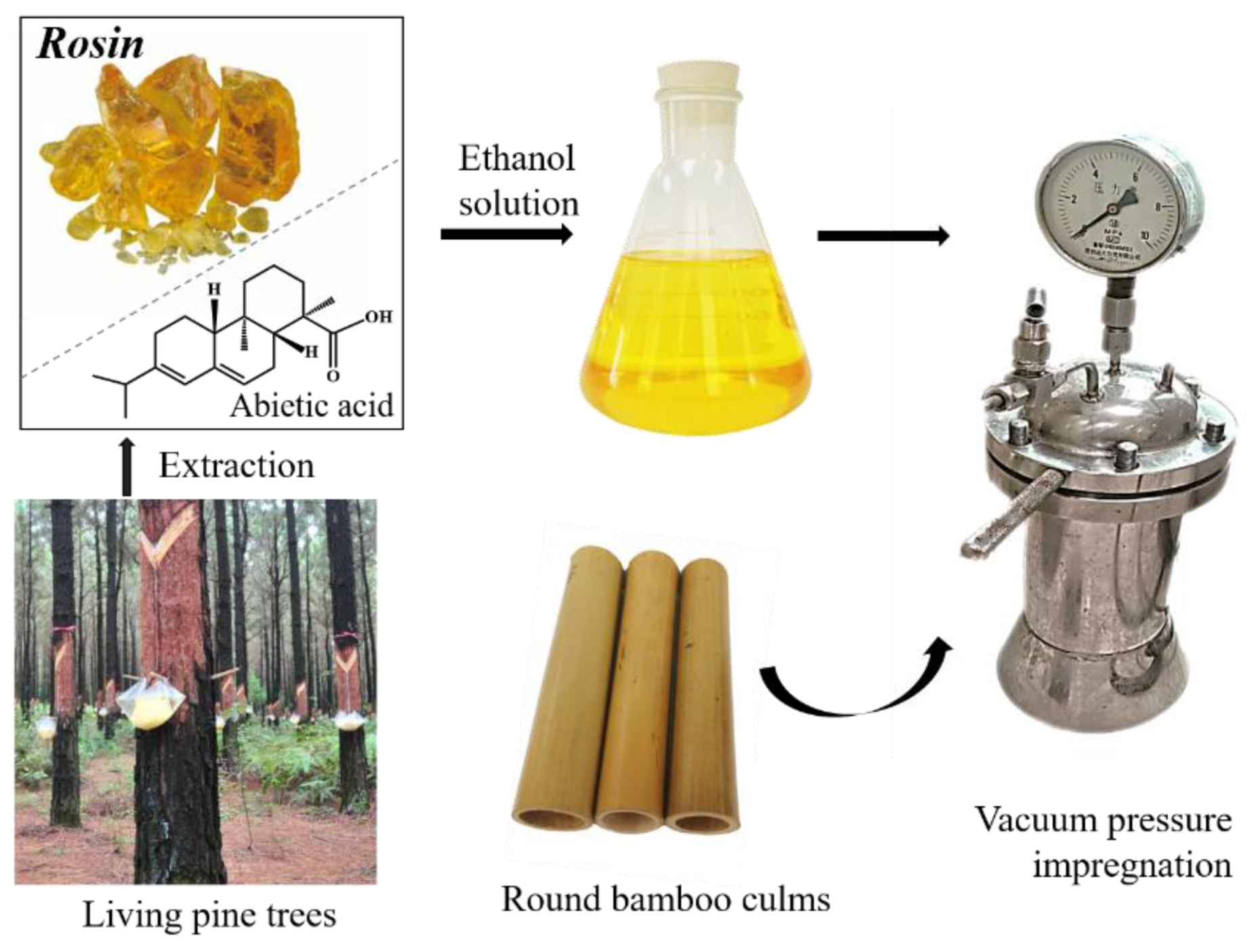

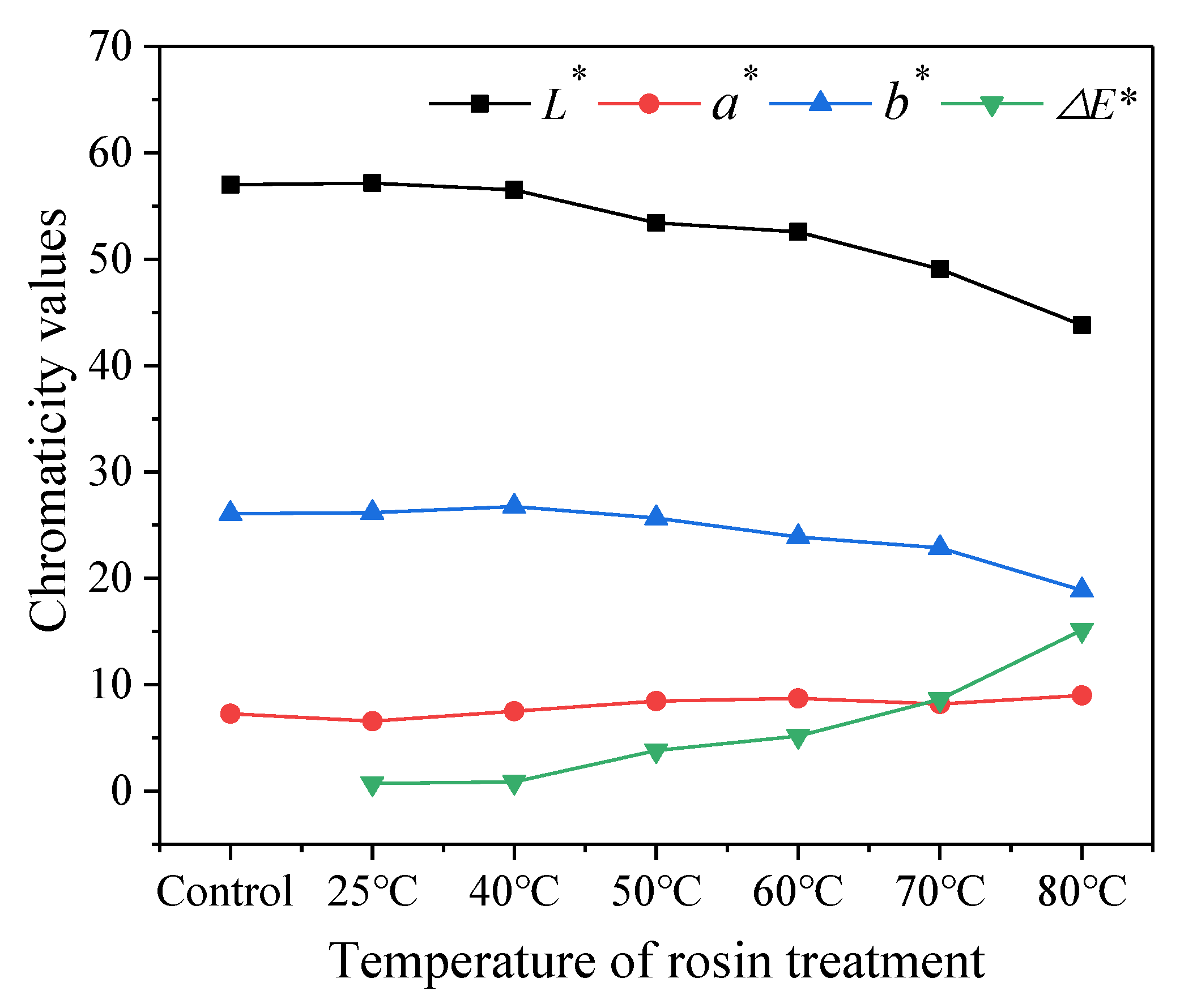
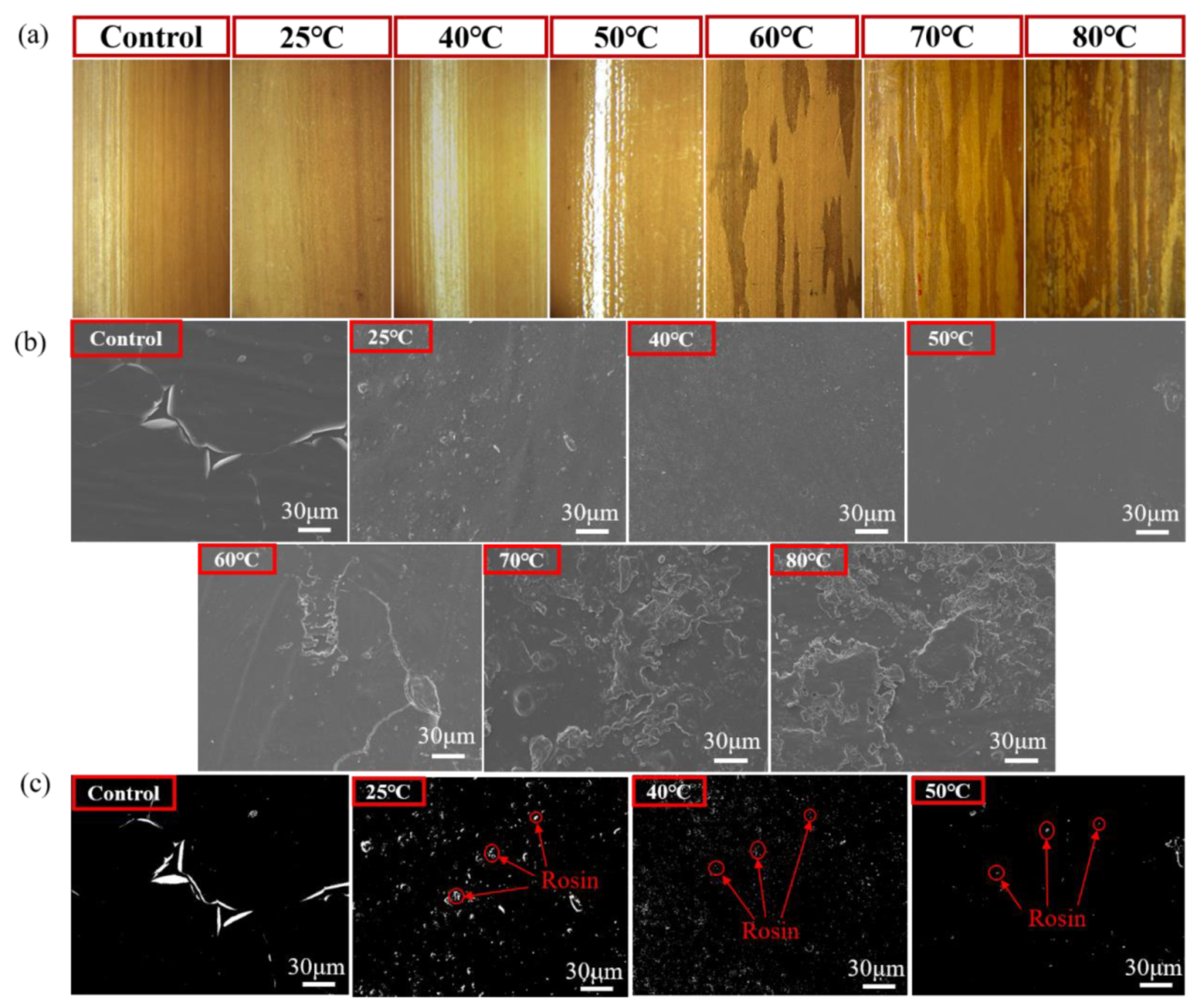

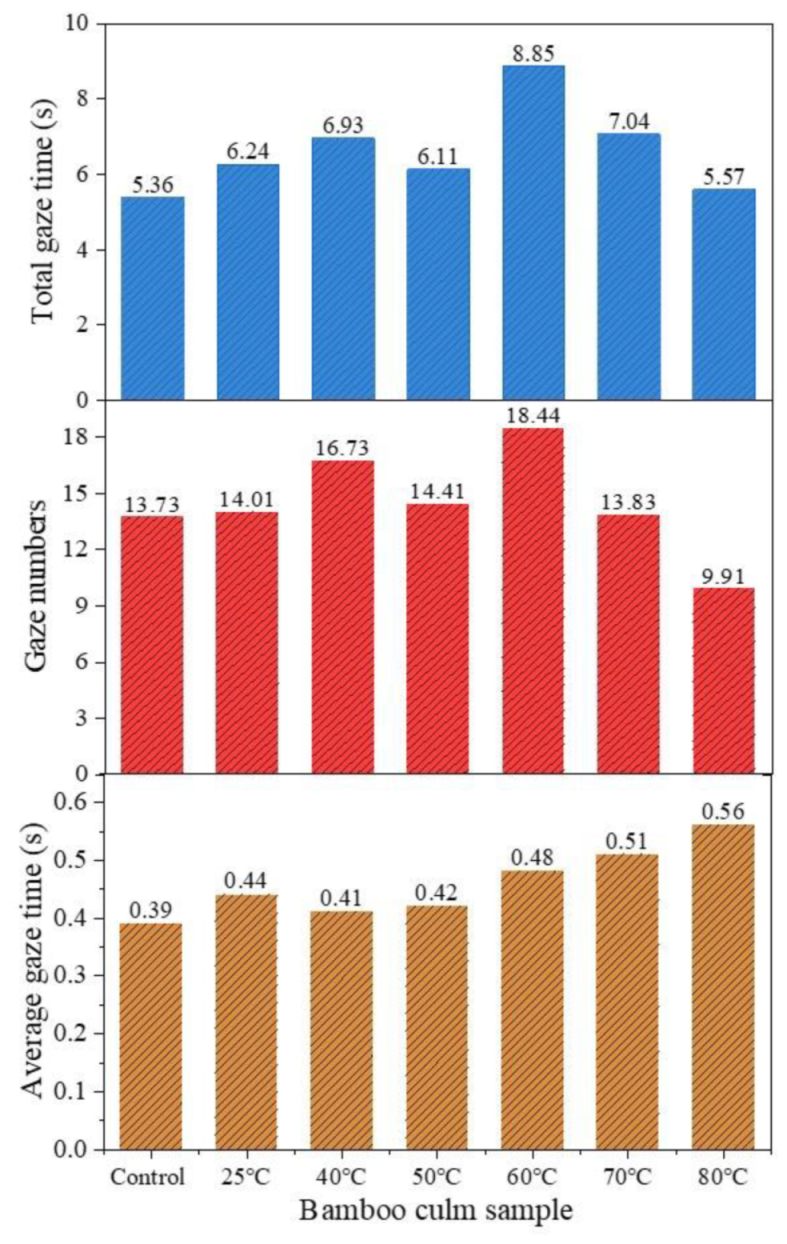

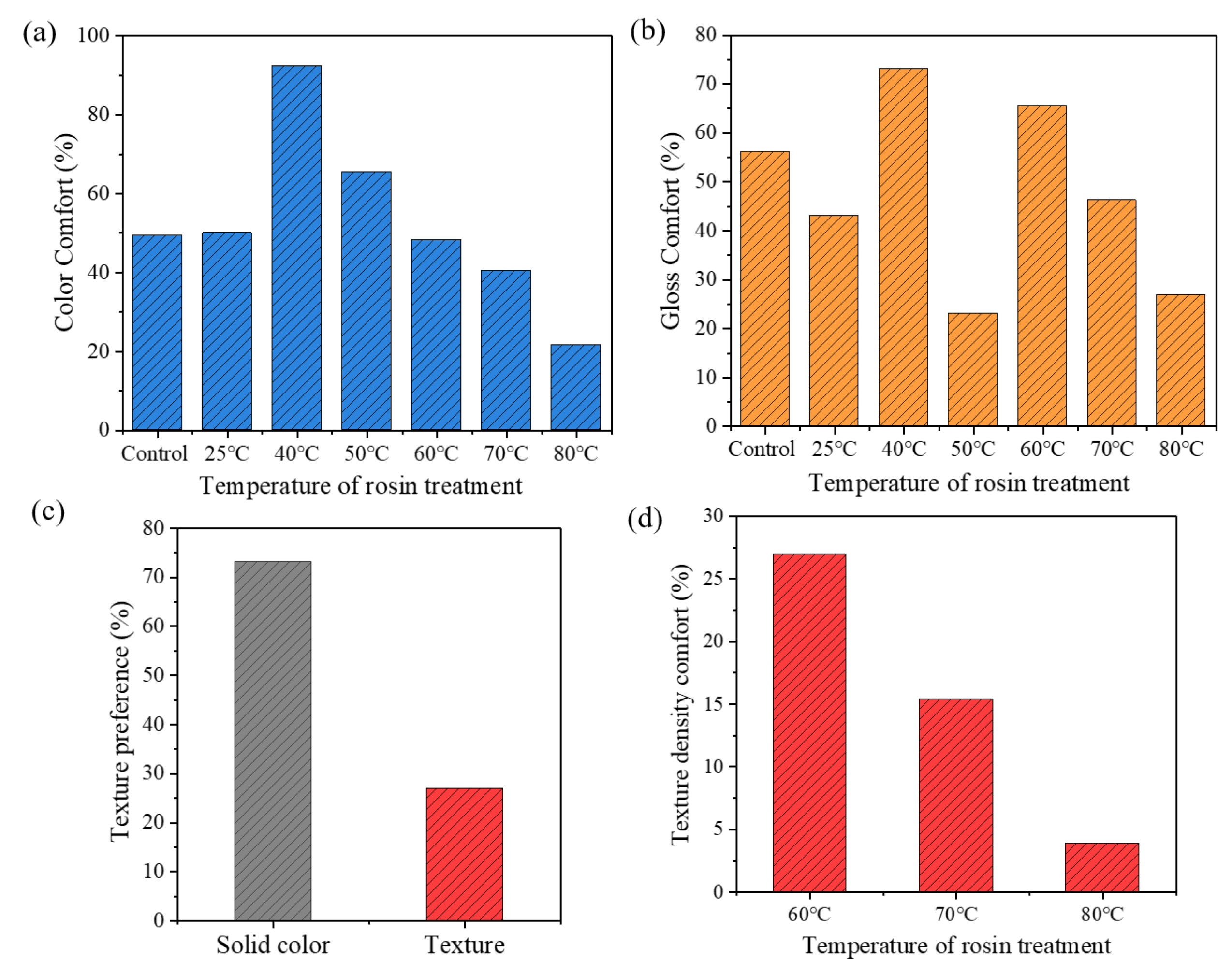
| Color | Gloss | ||||||||
|---|---|---|---|---|---|---|---|---|---|
| Bamboo Culm Sample | L* | a* | b* | ΔL* | Δa* | Δb* | ΔE* | ||
| Control group | 57.02 | 7.26 | 26.08 | / | / | / | / | 8.8 | |
| Rosin-treated group | 25 °C | 57.17 | 6.57 | 26.17 | 0.14 | −0.69 | 0.09 | 0.71 | 5.6 |
| 40 °C | 56.52 | 7.50 | 26.74 | −0.50 | 0.24 | 0.66 | 0.87 | 12.4 | |
| 50 °C | 53.43 | 8.46 | 25.66 | −3.60 | 0.20 | −0.42 | 3.81 | 19.6 | |
| 60 °C | 52.57 | 8.71 | 23.89 | −4.45 | 1.45 | −2.19 | 5.16 | 15.5 | |
| 70 °C | 49.07 | 8.19 | 22.87 | −7.95 | 0.92 | −3.21 | 8.62 | 12.9 | |
| 80 °C | 43.80 | 8.98 | 18.88 | −13.22 | 0.72 | −7.20 | 15.15 | 6.8 | |
Publisher’s Note: MDPI stays neutral with regard to jurisdictional claims in published maps and institutional affiliations. |
© 2021 by the authors. Licensee MDPI, Basel, Switzerland. This article is an open access article distributed under the terms and conditions of the Creative Commons Attribution (CC BY) license (https://creativecommons.org/licenses/by/4.0/).
Share and Cite
Su, N.; Fang, C.; Zhou, H.; Tang, T.; Zhang, S.; Wang, X.; Fei, B. Effect of Rosin Modification on the Visual Characteristics of Round Bamboo Culm. Polymers 2021, 13, 3500. https://doi.org/10.3390/polym13203500
Su N, Fang C, Zhou H, Tang T, Zhang S, Wang X, Fei B. Effect of Rosin Modification on the Visual Characteristics of Round Bamboo Culm. Polymers. 2021; 13(20):3500. https://doi.org/10.3390/polym13203500
Chicago/Turabian StyleSu, Na, Changhua Fang, Hui Zhou, Tong Tang, Shuqin Zhang, Xiaohuan Wang, and Benhua Fei. 2021. "Effect of Rosin Modification on the Visual Characteristics of Round Bamboo Culm" Polymers 13, no. 20: 3500. https://doi.org/10.3390/polym13203500
APA StyleSu, N., Fang, C., Zhou, H., Tang, T., Zhang, S., Wang, X., & Fei, B. (2021). Effect of Rosin Modification on the Visual Characteristics of Round Bamboo Culm. Polymers, 13(20), 3500. https://doi.org/10.3390/polym13203500






